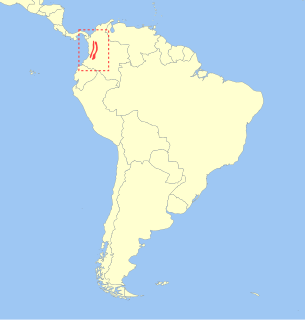Akodon is a genus consisting of South American grass mice. They mostly occur south of the Amazon Basin and along the Andes north to Venezuela, but are absent from much of the basin itself, the far south of the continent, and the lowlands west of the Andes. Akodon is one of the most species-rich genera of Neotropical rodents. Species of Akodon are known to inhabit a variety of habitats from tropical and tropical moist forests to altiplano and desert. Fossils are known from the late Pliocene onwards.

Akodon azarae, also known as Azara's akodont or Azara's grass mouse, is a rodent species from South America. It is found from southernmost Brazil through Paraguay and Uruguay into eastern Argentina. It is named after Spanish naturalist Félix de Azara.

The mamore arboreal rice rat,, also known as the Mamore oecomys is an arboreal species of rodent in the genus Oecomys of family Cricetidae. Its distribution extends over much of Bolivia and into nearby Brazil and Paraguay. Although Oecomys has been recorded from Argentina, it is uncertain whether those records represent O. mamorae. It is found in a variety of habitats at elevations from 200 to 2100 m, where it feeds on fruit and green seeds.
Akodon aerosus, also known as the highland grass mouse or Yungas akodont, is a species of rodent in the family Cricetidae. It is found in the eastern Andes from eastern Ecuador through Peru into central Bolivia.

Akodon affinis, also known as the Colombian grass mouse or Cordillera Occidental akodont, is a species of rodent in the family Cricetidae. It is found only in the Cordillera Occidental of Colombia.
Akodon boliviensis, also known as the Bolivian grass mouse or Bolivian akodont, is a species of rodent in the family Cricetidae. It is found in the Andes from southeastern Peru through Bolivia into northwestern Argentina.
Akodon budini, also known as Budin's akodont or Budin's grass mouse, is a species of rodent in the family Cricetidae. It is found in the Andes of northwestern Argentina and adjacent Bolivia. The species is named after Emilio Budin, an Argentine specimen collector who worked with Oldfield Thomas.
The smoky grass mouse is a species of rodent in the family Cricetidae. It is found in Argentina, Bolivia and Peru.
Koford's grass mouse is a species of rodent in the family Cricetidae. It is found only in Peru. It is named after American biologist Carl B. Koford.
The Altiplano grass mouse is a species of rodent in the family Cricetidae. It is found in Bolivia, and Peru.
The white-throated or grey-bellied grass mouse is a species of rodent in the family Cricetidae. It is found in Argentina and Bolivia.

Akodon spegazzinii, also known as Spegazzini's akodont or Spegazzini's grass mouse, is a rodent in the genus Akodon found in northwestern Argentina. It occurs in grassland and forest at 400 to 3,500 m above sea level. After the species was first named in 1897, several other names were given to various populations now included in A. spegazzinii. They are now all recognized as part of a single, widespread and variable species. Akodon spegazzinii is related to Akodon boliviensis and other members of the A. boliviensis species group. It reproduces year-round. Because it is widely distributed and common, Akodon spegazzinii is listed as "least concern" on the IUCN Red List.
The Puno grass mouse is a species of rodent in the family Cricetidae. It is found in Bolivia and Peru.

Akodon sylvanus, also known as the forest grass mouse or woodland akodont, is a species of rodent in the family Cricetidae. It is found only in a small part of northwestern Argentina.
The variable grass mouse is a species of rodent in the family Cricetidae. It is known only from Bolivia, where it is found at elevations from 400 to 3000 m.
The Andean vesper mouse is a species of rodent in the family Cricetidae. It is found in Argentina, Bolivia, Chile, and Peru.
Oxymycterus hucucha, also known as the Quechuan Hocicudo, is a species of rodent in the genus Oxymycterus of family Cricetidae from South America. It is found only in a small region of the Andes in central Bolivia, where it lives in cloud forest at altitudes from 2600 to 3000 m.

Akodon caenosus is a rodent in the genus Akodon found in northwestern Argentina and south-central Bolivia. Since its description in 1918, it has been alternatively classified as a separate species or a subspecies of Akodon lutescens. The species Akodon aliquantulus, described from some very small Argentine specimens in 1999, is now recognized as a synonym of A. caenosus.
Cerradomys scotti, also known as Lindbergh's oryzomys, is a rodent species from South America in the genus Cerradomys. It is terrestrial and is found in the cerrado (savanna) ecozone of south central Brazil, Bolivia and Paraguay. The species is common and appears to tolerate a degree of agricultural habitat modification.

Oryzomys albiventer is a rodent in the genus Oryzomys of family Cricetidae from interior western Mexico, in the states of Jalisco, Guanajuato, and Michoacán. First described in 1901 as a separate species, it was later lumped under O. couesi and the marsh rice rat (O. palustris) until it was reinstated as a species in 2009. It differs from neighboring Oryzomys populations in size and measurements and is a large, brightly colored species with a long tail and robust skull and molars. Its range has been much impacted by agricultural development, but isolated populations are thought to persist.







